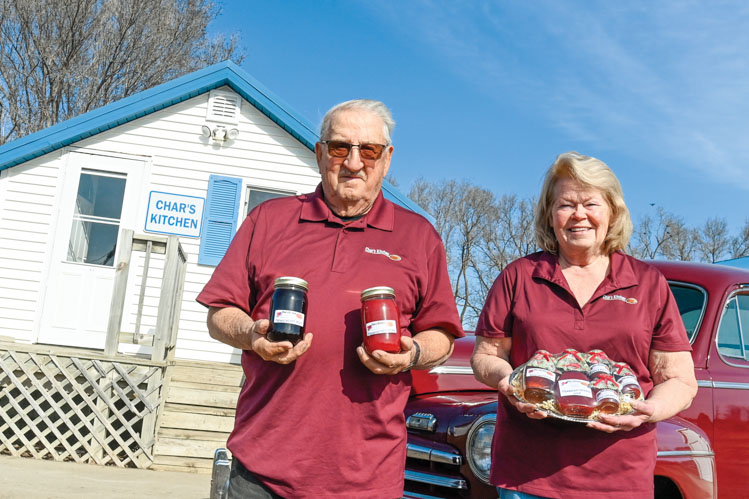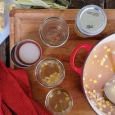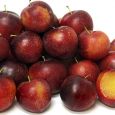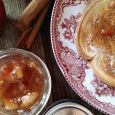The Gift of South Dakota
Subscriptions to South Dakota Magazine make great gifts!
Subscribe today — 1 year (6 issues) is just $29!
Turton’s Jelly Makers
 |
| Char Barrie has blazed a trail for other jelly makers and home kitchen entrepreneurs. She's known for quality products and a tireless approach to marketing, thanks in part to her husband Rolland, who still enjoys forays to fairs and shows. |
Life is sweeter in South Dakota thanks to Char Barrie, the Turton woman who turned a family farmstead into a popular jelly factory.
Growing up as one of five “Navy brats” in Oklahoma, there was never enough food in the house, so she began to cook at her mother’s knee. When the family moved to South Dakota in 1967, she learned even more from her grandmother in Doland, who introduced her to the wild berries and plums of Spink County.
She married Rolland Barrie, a farmer from Turton. They have six daughters. When their grandchildren began to arrive, Char filled some of the many baby food jars with jellies to give as gifts. Friends suggested that she sell her rhubarb jelly at a VFW crafts show in Doland in 1995. Soon, there weren’t enough grandbabies, so she began to order jelly jars by the hundreds. Today, Char’s Kitchen is likely the biggest jelly maker in South Dakota.
The home-grown business is headquartered in The Jelly House, a quaint little blue-and-white building that was formerly home to a bachelor farmer. “Mr. Huber was a nice old man,” Char says. “He lived five miles east of here. When he was older, he played cards all day at the kitchen table.”
The Barries moved the house, which is only 14 feet wide, to their farmyard in 1999 when they realized that the jelly business was outgrowing the kitchen. A few years later, they built a storage and shipping building next to The Jelly House. The newer building also stores Rolland’s 1946 Ford coupe, which happens to be the same purple color as the popular chokecherry jelly.
“Ford stopped manufacturing cars in 1942 and they started making Jeeps and tanks for the army,” he said. “This was one of the first cars built after the war.”
Rolland helps with packaging and shipping the jellies, and he tends a produce garden where some of the rhubarb and other fruits and vegetables are grown. In the early years, he and Char loaded their car with boxes of jellies and spent weekends at arts and crafts shows. They weren’t always successful.
“You learn to not take it too personal,” Rolland says. “You can be Jimi Hendrix at the Castlewood gymnasium, and just because no one shows up doesn’t mean you aren’t good on the guitar.”
Though Char’s Kitchen now sells jellies and other products online and at 34 shops and stores throughout the Dakotas and Minnesota, the Barries continue to pack boxes in a car and travel to shows. “We still do about 15 a year,” Char says. “It’s a chance to meet the customers face to face. We learn what they like, and it’s pretty sweet when someone says, ‘I love your jams.’ I never get tired of that.”
Years of cultivating customer relations at the shows is evidence of a marketing savvy and commitment that sets Char’s jellies apart from her competitors, says Kevin Fiedler, who operates Ken’s Super Fair Foods Store in Aberdeen and five surrounding towns in northeast South Dakota.
Fiedler watched the Barries’ business grow from the very beginning. “Char came to us as a wholesaler to purchase some of her supplies, the jars and lids and sugars and other products. We love having South Dakota products, so it was a no-brainer to find a nice location for her products on our shelves and they sell very well.”
The Aberdeen grocer says he sells cheaper jellies, but customers are loyal to the Turton jelly maker. “When you know something is produced in your backyard and you know the commitment and the consistent quality that Char provides, then you figure it’s sure worth the value.”
Fiedler believes her unique products also grab attention. “You’re not going to find Welches or Smuckers putting out a rhubarb or a South Dakota chokecherry jelly,” he laughs. And you aren’t likely to find those companies competing to pick the wild fruits that grow along the Spink County backroads.
Big-time competitors would also be jealous of the business networks that the Barries have fostered. For example, the staff at Ken’s Grocery in Aberdeen saves watermelon rinds that the Barries pickle and sell in jars (the rinds taste like peaches). Youth from the Hillside Hutterite Colony at Doland help to pick berries, and the colony gardeners grow cucumbers and green beans for them.
Kristi Barrie, a shirttail relative, is Char’s steady assistant with the jelly-making when she’s not running the Turton post office. Other neighbors and relatives also assist during busy seasons, such as when they make and package hundreds of jars of corn cob jelly for Mitchell’s Corn Palace gift shop.
Many South Dakota food hobbyists have dreamed of starting a home-based business, and some have tried. Few of them sell like the Barries.
On a summer afternoon, Char agreed to halt jelly-making long enough to share her thoughts on why she’s succeeded in a challenging and competitive food-making industry when so many others struggle. As she related her journey, Rolland drove the old Ford out of the shed so we could get a closer look.
“What really helped me was starting out slowly,” she says. “We made our mistakes when we were small. It has taken me 25 years to get where I am, and it really blossomed in just the last few years.”
Char didn’t use the word “persistence,” but it surely defines her approach and personality. Just as she was beginning, state health officials began to regulate cottage foods, a term used by bureaucrats that does seem to describe The Jelly House. Laws and regulations have been evolving ever since. Rather than fight the trend, she worked with lawmakers and bureaucrats to write reasonable regulations. In 2004 she was issued South Dakota’s first home-based food service license.
She invests in advertising and marketing campaigns, juggles the supply-chain issues and inflationary cost pressures that small businesses face today, and still finds time to launch products.
“Our newest is corn relish,” she says. “We had some people asking for it. Rolland didn’t think he’d like the cabbage, but he says it’s good.”
The Barries have also started to make syrups for pancakes, waffles and ice cream. “We are doing chokecherry, raspberry, cinnamon, elderberry and four varieties with rhubarb — strawberry, blueberry, raspberry and apricot rhubarb.”
“Oh, we also make a pickled asparagus,” she says. “It’s very good with beer.”
For special orders and gift baskets, she wraps festive cloth around the lids of the 8-ounce and 16-ounce jelly jars. The fabric designs in the shipping room include walleye, camouflage and farm implements. “You never know what’s going to catch peoples’ eyes,” she laughs. “Rolland loves it when I go to the fabric store.”
“That’s an hour-and-a-half stop,” he groans.
On a typical day at the farm, Rolland tends to the garden while Char and Kristie work in the kitchen. She says there are a lot of steps to the process of jelly-making. “First, we wash the fruits and vegetables. Then we cook the fruit to get the juice. You have to measure the sugar. You have all the jars sterilized, washed and ready. You mix the jelly. You fill the jars, label them — some we decorate with the fabric.”
She says most jars are handled five times, and maybe more if they are packed and loaded for a craft fair.
Last year, Char’s Kitchen used 12,000 jars. Annually, she averages 2 tons of sugar, 1,000 pounds of rhubarb and 1,600 pounds of chokecherries.
Strawberry-rhubarb jelly is the most popular product, followed closely by raspberry-rhubarb, blueberry-rhubarb and apricot-rhubarb. “South Dakotans do like rhubarb,” Char says. Chokecherry is also a good seller. Char’s Kitchen also produces apple butter, pickles, salsas and other spreads and sauces.
The Barries are in their early 70s and showing no signs of slowing the pace. “We do take time off for blizzards, holidays and fishing,” Char says. “We like to go walleye fishing at Mobridge. Other than that, you’ll find us here making jelly.”
Unless, of course, you see the couple cruising Spink County’s rural roads in their chokecherry-purple Ford coupe.
Editor’s Note: This story is revised from the September/October 2023 issue of South Dakota Magazine. To order a copy or to subscribe, call (800) 456-5117.










Comments